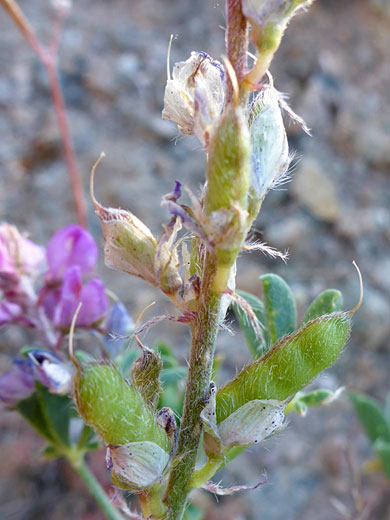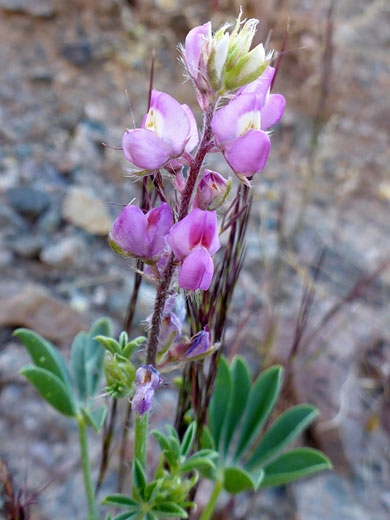
Elongated flower cluster; lupinus arizonicus, Bristol Mountains, Mojave Trails National Monument, California
Common name:
Arizona lupine
Family:
Scientific name:
Lupinus arizonicus
Main flower color:
Range:
South California, south Nevada and west Arizona
Height:
Up to 20 inches
Habitat:
Washes, sandy flats and hillsides; up to 3,500 feet
Leaves:
Divided into 6 to 10 oblanceolate leaflets, up to 1.5 inches long and 0.4 inches wide
Season:
March to May
Lupinus arizonicus is a plant of the Mojave and Sonoran deserts; it is most widespread in south California but also common in west Arizona. The reddish-green stems are covered both by short, strigose hairs, and longer, straggly, spreading hairs. Leaflets have a sparse hair covering only on the lower surfaces; the upper surfaces are hairless. Leaves are borne on stalks of up to 3 inches; about twice as long as the leaflets. Leaves can be numerous, and the plant forms dense, low clumps, with the flower stalks rising above the leaves.
The inflorescence is a vertical, elongated cluster up to 50 of spirally-arranged flowers, attached by short stalks. Each flower is subtended by a narrow, hairy bract, around a quarter of an inch long. The calyx is also hairy, and deeply divided into five equal-length lobes. The banner petal and the similarly-sized wing petals are initially colored pink to purple, becoming bluish or sometimes white as they mature. The center of the banner is marked by a few yellow spots, pinkish with age. Seed pods are roughly strigose hairy, around one inch long.
The inflorescence is a vertical, elongated cluster up to 50 of spirally-arranged flowers, attached by short stalks. Each flower is subtended by a narrow, hairy bract, around a quarter of an inch long. The calyx is also hairy, and deeply divided into five equal-length lobes. The banner petal and the similarly-sized wing petals are initially colored pink to purple, becoming bluish or sometimes white as they mature. The center of the banner is marked by a few yellow spots, pinkish with age. Seed pods are roughly strigose hairy, around one inch long.
All Contents © Copyright The American Southwest | Comments and Questions | Contribute | Site Map



